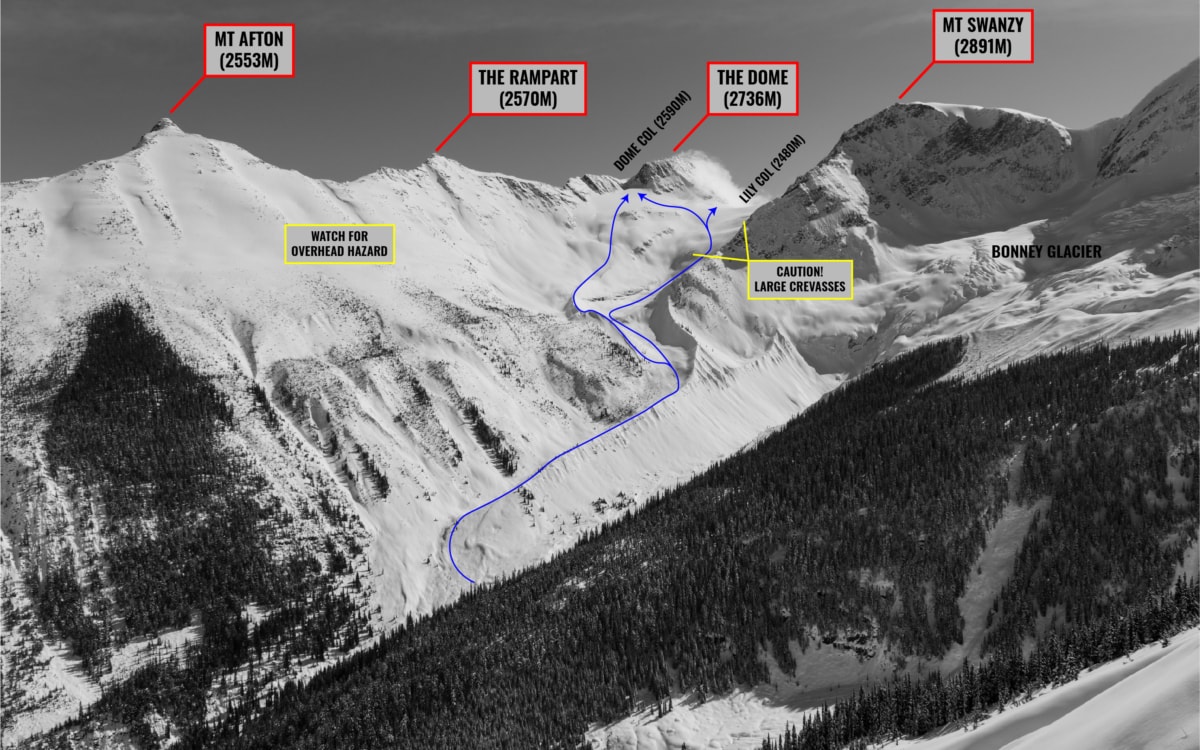The last day of temperature inversion called for a proper adventure. We decided on completing the Dome Col Traverse. Our route would take us up the Lily Glacier in the Loop Brook Valley, through the col, and down the Dome Glacier in the Asulkan Valley. It’s an ultra-scenic ski tour that takes you through one of Rogers Pass’ famed perch. With the right glacier travel and crevasse rescue training, I highly recommend the Dome Col Traverse to anyone looking for spectacular views and a good push.
This route is located within a Winter Restricted Area (WRA) governed by the Winter Permit System. Please check the WRA status before travelling through it.
Related: Sapphire Col Traverse: An Alpine High

Report from December 3, 2020
I assembled the team: Iannick and Freddy, two experienced backcountry skiers that I would trust with my life if shit was to hit the fan. Our day began at the Loop Brook parking lot, frozen solid by the cold morning breeze. It’s no understatement that this drainage is an ice-box, being surrounded by some very serious glaciers. After a prompt transceiver check, we slogged up the Loop Brook, crossing fast-moving water at the Elephant Trunk. From there, we were but a short bushwhack away from the narrow moraine leading up to the Lily Glacier. Let’s call that one the Lily Moraine.

Along the way, we observed the presence of surface hoar, on sheltered aspects, noticeable by the magical glimmer the crystals produce as they reflect sunlight. We quickly hopped on the Lily Moraine, a high-ground route that would negate the overhead avalanche hazard from the exposed west slope of Mt Afton. The Bonney massif stood high above us with its heavily-crevassed glacier lying at the base of its headwall. From our perch, we could spot the Dome and its col, the high point of the Dome Col Traverse.
Surface Hoar Facts
We shimmied along the Lily Moraine until we cleared the hazard posed by Mt Afton as the tree cover started to thin out. From there, we traversed through the low ground and connected with yet another moraine, looker’s left of the Lily Glacier, which was barely in our view at that point. This was a painful reminder of global warming’s impact on small glaciers. The small toe had receded halfway up the valley, now only a few hundred meters below the Lily Col.

Eventually, the height-of-land walk came to an end as we reached the end of the moraine, just a little above treeline. We now faced the rocky, wind-scoured west face of the Rampart, a broken, knife-edge ridge that looks like the back of a stegosaurus. Let my nerdy Jurassic reference sink in with you a bit!

Since we planned on traversing below the slope, the overhead hazard was worth discussing. Things were looking good: the natural avalanche cycle happened more than a week ago, the aspect, albeit solar, wasn’t warmed up enough by the low-lying December sun and the ridgetop winds would remain calm for the foreseeable future. Excellent! During a brief lunch break, we met two aspiring ski guides, Jeff and Joe, people I consider friends and touring partners to this day. They unintentionally joined us for the ascent since we advanced at nearly the same pace.

We began the uneventful crossing under the west face of the Rampart. Uneventful is good! The katabatic winds had done a number on the snow’s surface. The 20cm of dry powder below turned into a hard crust. It took all the edging I could muster to maintain traction on the wind-affected snow. I was damning myself for now bringing ski crampons. Somehow, Iannick had no trouble dealing with the side-hilling as he bolted way past us on his fruitless quest to drain his infinite supply of energy.
Katabatic Wind Facts
We escaped the Rampart’s crosshair just as the snow was visibly warming up, a reminder that moist snow spells disaster. We pressed on towards the upper bench of the Lily Glacier. As we crossed above the Lily Col (2480m), the winds, funneled through the terrain constriction, dramatically picked up to the point where they almost knocked Freddy over. We felt like one of those polar explorers forging a path through a frozen landscape riddled with sastrugi.

Once we reached the toe of the upper Lily Glacier, we donned the glacier travel and crevasse rescue equipment, aka all the dangly bits. After a short refresher on glacier rope management, we began the short pilgrimage up the glacier, now roped up. It’s worth noting we roped up for practice since the Lily Glacier is barely crevassed. Usually, I don’t bring the gear up there but it doesn’t hurt to be on the cautious side.
Glacier Travel Basics
We eventually reached the base of the Dome Col, caked with faceted snow. I knew the sugary snow would make booting up the rock slab a chore. We packed away our glacier gear and prepped our backpacks for the short stint up the col, now lying in the shadow of the Dome.

To my surprise, the bootpack was easier than expected. Jeff and Joe made short work of it, following a well-established track that was put in a few days ago. Within minutes, Jeff and Joe who were now standing proudly at the top of the col. Looking back, the views of Rogers Pass were absolutely stunning. This is a one-of-a-king valley!

With much time to spare, we gained the Dome Col and peered past the Dome Col into Asulkan Valley, magical as always. A hundred meters away, our impromptu partners were perched above the Asulkan Glacier on a prominent ridge dividing the latter from the Dome Glacier, called the Cleaver. The Jupiter massif was standing high in the distance, towering over the Asulkan, a view that granted me a good bit of insight into the surrounding terrain. Those terrain photos will come in handy when I’ll be attempting the Jupiter Traverse in spring.

After a good fifteen minutes of rest, we clipped in our bindings and transitioned from the Cleaver onto the Dome Glacier through a precarious wind-battered ramp. This was now the second part of the Dome Col Traverse. The snow was without a doubt gross, an unavoidable fact of life when skiing exposed alpine terrain. Slow, cautious turns were the names of the game.

Surface conditions improved past the ramp. The wind-affected snow turned into light, fluffy powder. Based on our local observations as well as the avalanche forecast which indicated a “moderate” hazard at al[pine elevations, we decided on skiing the Dome Roll, a large convexity leading into a steep glacial slope. Otherwise, we would have veered right following the Cleaver and dropped into a mellower grade.

From the top of the glacier, the slope seemed to roll off into the unknown. I’ve got a particular dislike for rolling glaciers since I don’t get to scope out the crevasses below. After sending it off a serac in Chamonix on one of those, I learned my lesson. Nonetheless, the slope’s grade past the convexity took me by surprise, at which point I gained a little too much speed for my lightweight skis to handle. Luckily, conditions were prime for a quick brake as soon as I realized my predicament.

After sharing our stoke at the bottom of the glacier, we sneaked through a narrow, icy choke, located skier’s left of the Dome Headwall, a steep rock slab below the glacier’s toe. I was struck by the beauty of this feature, covered in clear blue ice! How pretty! We traversed a series of convoluted moraines towards the foothill of Mt Afton, only to burst through a pillow field right above the Asulkan Brook. From there, we performed the usual slog out of the Asulkan Valley and traversed back along the highway to the Loop Brook parking lot in the dark with the loud rumble of trucks whizzing by us.
With good terrain knowledge and proper training, the Dome Col Traverse is an accessible, uber-scenic alpine traverse along with the Little Sifton Traverse and the Sapphire Col Traverse. Highly recommended, go do it! Hire a guide if necessary. It’s worth its weight in gold.
Statistics
| Peak Elevation | 2590m |
| Vertical Gain/Loss | 1600m |
| Distance Traveled | 18km |
| Duration | 7h |
For more beta on my adventures, check out the Route Map. This online map interface is a repository of my ski touring and mountaineering adventures. Simply follow the rough trace!
